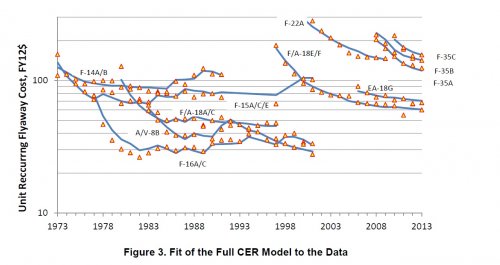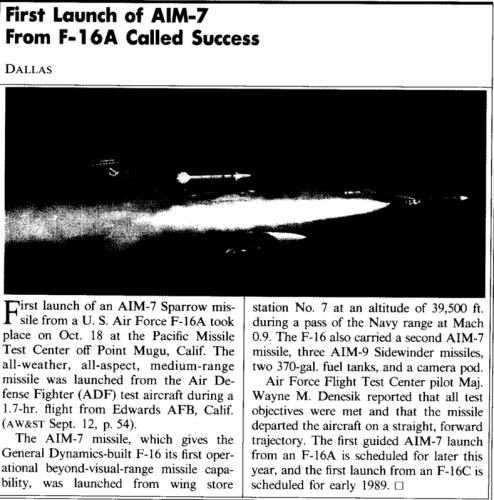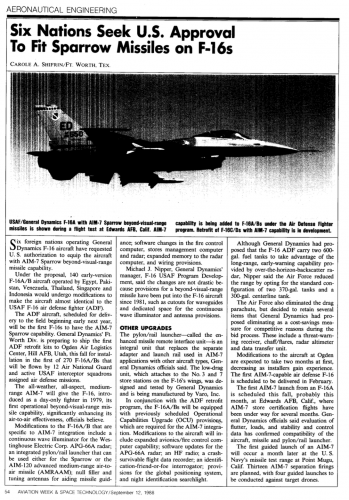LowObservable said:
Please produce contemporary sources for complaints, let alone "howls" about short range.
Yeah, sure, I'll just conjure up magazines from 35 years ago, many of which aren't even in business anymore. :

Are you really going to try to pretend there weren't complaints about how the F-16 came up short in many regards compared to the F-4 it was replacing? I can only imagine how it would have played out were the internet what it is today back then. We'd have been hearing how inferior the F-16 was compared to the rejected 5th Gen Viggen with it's BVR and short field capability, and how the F-16 was much slower than the proposed Mirage F-1E. "Has no BVR, can't guide LGBs, useless at night, can't carry as many bombs as the F-4, etc. etc. etc." And yet here we are today with the F-16 pretty much universally recognized as one of the most successful fighters of the last 50 years, with a kill record to match.
Just looking through Lou Drendal's Squadorn Signal publication from 1981. My, my, my it's like deja vu.
"The GAO also questioned the pace of the test program, but the Air Force replied that of
32 milestones to be accomplished before the production decision, only one appeared to
be in any trouble. The GAO also questioned the escalating cost of the F-16. The Air Force
replied that it could justify all increases In the total program cost, which should have been
relatively easy, given the overall tendency of government to spend far In excess of it's
ability to pay. The GAO questioned the impact on costs that European participation in the
program would have. The Air Force replied that the added volume generated by the NATO
buy would more than make up for any increases in costs. The GAO questioned whether or
not the F-16 in fact needed the capability to fire radar guided missiles, as stated in the
Tactical Air Command report on the F-16, and they questioned the survivability of the F-16
in the air-to-ground role, which had been added to the F-16's missions. The GAO report
concluded that the F-16 was highly vulnerable to projectile and missile warhead
fragments from both air-to-air and air-to-ground threats. As a result of this report, USAF
directed General Dynamics to accelerate it's reassessment of F-16 survivability. However,
the Air Force took strong exception to the overall tenor of the GAO report, stating that
most of these perceived problems had either been anticipated and were in the process of
being fixed, or had already been fixed. In spite of this, the GAO issued another critical
report exactly one year later, urging complete DOD review of the F-16 program before the
Air Force went ahead with it's planned buy of an additional 738 F-16s, which would bring
the total USAF buy up to 1,388 aircraft. This report questioned structural integrity, radar
operation, flight stability, anti implementation of the Foreign Military Sales plan. The Air
Force provided point by point rebuttal of the GAO's allegations, and the program continued
apace."
. . .
"In the meantime,
a moderate mutiny was brewing among USAFE commanders. They
worried that the F-16 would be too vulnerable to Soviet fighters with beyond-visual-range
(BVR) radars, and were reluctant to accept F·16s if they had to give up their F-4s. (The F·4
was equipped with the BVR Sparrow Missile) The F-16 had demonstrated the ability to fire
the Sparrow during the test program, so the primary diff iculty was with the relatively sim·
pie radar in the F-16. The Air Force promised to look into the possibility of upgrading the
radar,"
Wow, imagine how today's media would blow this up if it were modern commanders not wanting to give up their F-16s for F-35s. The intertubes would melt and the usual suspects would wear the prints from their fingers with the amount of "news" they'd churn out.
"But, by that September, when the F-16 made it's first appearance at the Farnborough
Air Show, the Consortium was voicing concern that they would have to shut down their
production lines if additional third country orders were not forthcoming within the next
few months. (The Dutch were the only members of the Consortium to agree to purchase
additional F-16s, having made the decision to replace their NF-5s.)"
*GASP* Shocking, just. . .shocking.
As for range:
"During Coronet Falcon, the 4th TFS deployed from Hill AFB, Utah to
Flesland Air Station, Bergen, Norway, with a 10 hour, non-stop f light. The F-16s did this
with three refuellings, the last a precautionary move in case bad weather was encountered
at the destination. Lt. Col. Gary Michels, C.O. of the 4th, and a veteran of a
similar F-4 deployment, stated that the F-4 would require 7 or 8 refuellings for the same
mission, and would have used more than five times as much fuel."
It's interesting that the Col. would go out of his way to make the comparison to the F-4. It's almost as if people thought the F-16 would have less range.
And of course this:
"The air-to-air threat was provided by RAF Lightnings and Phantoms, which attempted to
intercept from within five minutes of takeoff, until the F-16s had landed. The F-16s not
only were the most accurate bombers, they also scored 86 kills in air-to-air combat, with
no losses! By contrast, the four other teams suffered 42 losses to the air-to-air threat,
while scoring only one kill in defense. Ground crews averaged a 10.5 minute turn-around
in refuelling and rearming with six MK-82 500 pound bombs and 515 rounds of 20MM
ammunition."
Of course today this would be explained away as a piece of "scripted propaganda".
Yep, it sure is interesting reading through "contemporary accounts".









